Defenses for Fall 2011
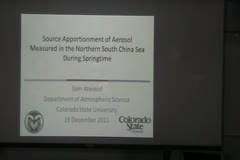
Source Apportionment of Aerosol Measured in the Northern South China Sea During Springtime
December 19, 2011
Sam Atwood
Large sources of aerosol are known to exist in Asia, but the nature of these sources and their impacts on surface particulate matter concentrations are presently not well understood, due in part to the complex meteorology in the region and the lack of speciated aerosol observations. This work presents findings from a pilot study that was aimed at improving knowledge in these areas. Aerosol was…
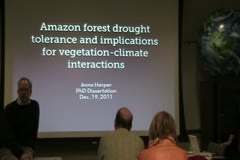
Drought Tolerance and Implications for Vegetation-Climate Interactions in the Amazon Forest
December 19, 2011
Anna Harper
On seasonal and annual timescales, the Amazon forest is resistant to drought, but more severe droughts can have profound effects on ecosystem productivity and tree mortality. The majority of climate models predict decreased rainfall in tropical South America over this century. Until recently, land surface models have not included mechanisms of forest resistance to seasonal drought. In some…
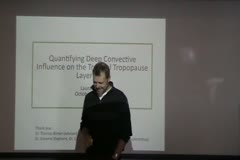
Quantifying Deep Convective Influence on the Tropical Tropopause Layer (TTL)
October 27, 2011
Laura Paulik
The transition between the troposphere and the stratosphere is best described as a layer containing both tropospheric and stratospheric characteristics. In the tropics, this region is known as the Tropical Tropopause Layer (TTL). The TTL roughly spans the altitude range of 12-18 km, bounded from above by the cold point tropopause (CPT) and from below by the main convective outflow level. This…
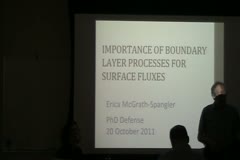
Importance of Boundary Layer Processes For Surface Fluxes
October 20, 2011
Erica McGrath-Spangler
An idealized experiment examined the impacts of entrainment in a coupled ecosystem-atmosphere model by implementing an enhanced entrainment parameterization based on the assumption that the heat flux at the top of the PBL is negatively proportional to the heat flux at the surface. This experiment found that entrainment produced a warmer, drier, and deeper PBL and that the surface fluxes of…
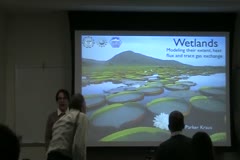
Modeling wetland's extent, their surface heat fluxes and exchange of carbon dioxide and methane
October 18, 2011
Parker Kraus
Though wetlands cover only a small percentage of the terrestrial land surface, 3-8%, their soils contain an outsized proportion, perhaps a quarter, of the terrestrial carbon store. Wetlands are also the largest and most variable natural source of atmospheric methane. As such, wetlands form a vital component of the of the climate system, particularly given their prevalence at high latitudes and…
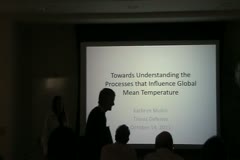
Towards Understanding The Processes That Influence Global Mean Temperature
October 14, 2011
Kate Mullin
Global mean surface temperature variability is largely determined by the global mean surface energy budget, which is driven by many natural and anthropogenic forcings. In theory, if all natural sources of global mean temperature variability could be removed from the global mean temperature time series the anthropogenic signal would be clearer. Previous studies have exploited this reasoning…
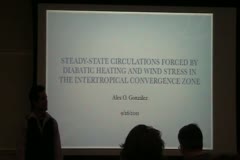
Steady-State Circulations Forced By Diabatic Heating and Wind Stress in the Intertropical Convergence Zone
September 26, 2011
Alex Gonzalez
A number of studies have shown the importance of using idealized models to gain insight into large-scale atmospheric circulations in the tropics, especially when investigating phenomena that are not well understood. The recent discovery of the Shallow Meridional Circulation (SMC) in the tropical East Pacific and West Africa is a perfect example of a phenomenon that is not well understood (Zhang…
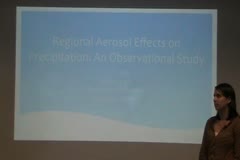
Regional Aerosol Effects On Precipitation: An Observational Study
September 08, 2011
Katie Boyd
There have been a multitude of studies on the effects increased amounts of aerosols may have on clouds. The connection between increased cloud condensation nuclei (CCN) and cloud microphysics has been established by in situ observations as well as modeling studies. However, the impact on precipitation is less well established. Of the studies that have assessed aerosol effects on precipitation…
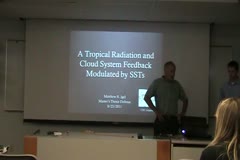
A Tropical Radiation and Cloud System Feedback Modulated by Sea Surface Temperature
August 25, 2011
Matt Igel
A large domain, high resolution cloud system resolving model set up in the tropics over fixed sea surface temperatures (SST) of 298 K and 302 K and run to radiative convective equilibrium has been analyzed with the focus on well equilibrated, domain mean results. The Regional Atmospheric Modeling System (RAMS) is used. The model organizes into disturbed, convective and undisturbed, subsidence…
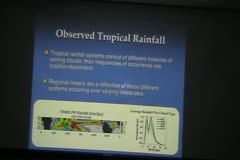
Tropical Rainfall Regimes and Their Evolution on Hourly to Daily Timescales
August 24, 2011
Greg Elsaesser
Data from multiple satellite and in situ sources are used to investigate the dominant raining cloud populations in the tropics, with the purpose of documenting how diverse the raining cloud populations are at any given time over a scale similar in size (~100 – 200 km) to that of a present-day global climate model (GCM). For all locations in the tropics, three similar rainfall clusters…
